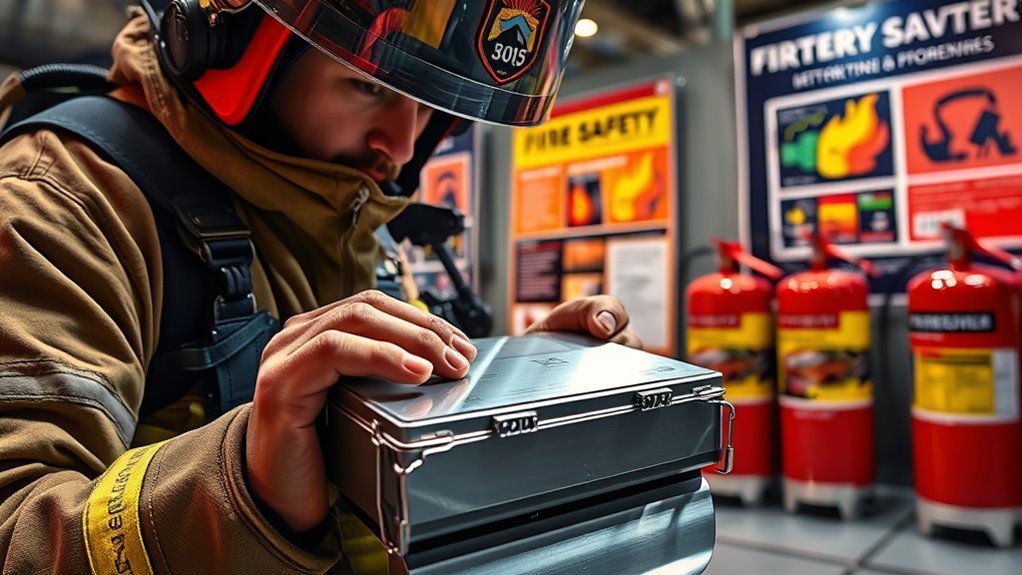During National Fire Prevention Week 2025, the focus is on battery safety to help you prevent fires and stay safe. As batteries are used more in devices like smartphones and EVs, understanding risks and proper handling becomes essential. You’ll learn how to spot signs of damage, handle batteries correctly, and respond effectively in emergencies. Staying informed and practicing safety can make a big difference—keep going to discover how to protect yourself and your community.
Key Takeaways
- Emphasize proper handling, storage, and disposal of batteries to reduce fire risks during National Fire Prevention Week 2025.
- Promote awareness of battery malfunction signs, such as swelling and leaks, and appropriate emergency responses.
- Highlight the importance of using certified chargers and regular inspections to prevent battery-related fires.
- Educate communities on safe extinguishing techniques for battery fires, including suitable fire extinguishers.
- Encourage community engagement through workshops, safety resources, and battery recycling initiatives during the event.
The Growing Importance of Battery Safety in Fire Prevention

As the use of batteries in everything from smartphones to electric vehicles continues to grow, so does the risk of fires caused by battery failures. You need to understand that batteries store large amounts of energy, and if they malfunction or get damaged, that energy can be released suddenly, leading to fires or explosions. This makes battery safety more critical than ever. Being aware of proper handling, charging, and storage practices helps prevent accidents. Manufacturers are also working on improved designs and safety features to reduce risks. However, your role is essential—regularly inspecting devices, avoiding overcharging, and using certified chargers can make a real difference. Additionally, understanding high-quality projectors can help prevent overheating issues that might contribute to fire hazards in home entertainment setups. As batteries become more integrated into daily life, prioritizing safety becomes crucial to protect yourself and those around you.
Common Types of Batteries and Their Risks

Different battery types pose unique safety risks you should understand. Lithium batteries can overheat and catch fire if damaged or improperly handled, while nickel-cadmium batteries release toxic fumes if punctured. Even common alkaline batteries can leak or explode if mishandled or damaged. Increasing use of batteries in everyday devices emphasizes the importance of understanding battery safety to prevent accidents.
Lithium Battery Hazards
Have you ever wondered about the risks associated with lithium batteries? These powerful batteries are common in smartphones, laptops, and electric vehicles, but they come with hazards. First, they can overheat and catch fire if damaged or improperly handled. Second, puncturing or crushing a lithium battery can cause a thermal runaway, leading to explosions. Third, manufacturing defects or manufacturing damage may result in internal short circuits, increasing the risk of fires or leaks. Because of these hazards, it’s vital to handle lithium batteries carefully, avoid exposing them to high temperatures, and never attempt to open or puncture them. Proper disposal and storage are essential to prevent accidents. Being aware of these risks helps you stay safe and protect your home and loved ones. Additionally, understanding battery safety measures can significantly reduce the likelihood of accidents and injuries.
Nickel-Cadmium Risks
Nickel-cadmium (Ni-Cd) batteries are common power sources for devices like cordless phones, emergency lighting, and power tools, but they carry specific risks you should be aware of. These batteries contain toxic cadmium, which is hazardous if leaked or improperly disposed of. Overcharging or deep discharging Ni-Cd batteries can lead to overheating, swelling, or even rupture, posing fire hazards. They are prone to a phenomenon called “memory effect,” which reduces capacity if not fully discharged regularly. Additionally, if damaged, they can leak corrosive chemicals that harm skin and eyes. Proper handling, storage, and disposal are essential to minimize risks. Never puncture or attempt to open these batteries, and always follow manufacturer guidelines to ensure safe use and prevent potential accidents. Regular inspection and maintenance can help prevent issues related to battery performance and safety.
Alkaline Battery Dangers
While nickel-cadmium batteries pose certain health and safety risks, alkaline batteries, which are among the most common household power sources, also carry their own dangers if not handled properly. If you mishandle these batteries, you risk leaks, fires, and chemical burns.
Here are key dangers to watch out for:
- Leaks and Corrosion – Over time, batteries can leak alkaline electrolytes, damaging devices and irritating skin or eyes.
- Swelling and Rupture – Excessive heat or puncturing can cause batteries to swell or rupture, releasing harmful substances.
- Fire Hazards – Improper disposal or short-circuiting can ignite alkaline batteries, leading to fires or explosions.
Always store batteries in a cool, dry place and dispose of them properly to prevent accidents.
Recognizing Signs of Battery Malfunction or Damage

Being able to spot signs of battery malfunction or damage is essential for your safety. If a battery leaks, it may release a foul odor or show corrosion around the terminals. Swelling or bulging in the battery case indicates internal damage and risk of rupture. Discoloration or leakage of fluid is a clear warning sign of deterioration. If a battery becomes excessively hot or cold without reason, it’s a sign something’s wrong. Additionally, if your device’s performance suddenly drops or it won’t turn on, the battery might be damaged. Always inspect batteries regularly, especially if they’ve been dropped or exposed to extreme temperatures. Proper maintenance and timely replacement can prevent accidents, fires, or injuries, ensuring you handle batteries safely and effectively.
Best Practices for Proper Battery Handling and Storage

To guarantee safety and prolong battery life, it’s crucial to handle and store batteries properly. First, always keep batteries in a cool, dry place away from direct sunlight or heat sources to prevent overheating. Second, store batteries separately, ideally in their original packaging or in a designated container, to avoid contact with metal objects that could cause short circuits. Third, handle batteries gently—avoid dropping or puncturing them, which can damage the internal components. When inserting or removing batteries from devices, follow manufacturer instructions to prevent accidental damage or leaks. Regularly check for corrosion, leaks, or swelling, and replace damaged batteries immediately. Additionally, be aware that battery capacity can influence how long a device operates and how safe it is to handle. Adhering to these best practices reduces fire risks and extends your batteries’ lifespan.
Safe Disposal and Recycling of Batteries

Proper disposal and recycling of batteries are essential for preventing environmental harm and conserving resources. When batteries are thrown away improperly, toxic chemicals can leak into soil and water, harming wildlife and humans. To avoid this, always take used batteries to designated recycling centers or collection points. Many stores and community programs accept rechargeable and single-use batteries for recycling. Before recycling, ensure batteries are stored in a safe, dry place and protected from damage. Never dispose of batteries in regular trash or incinerate them, as they can cause fires or release hazardous materials. Recycling batteries helps recover valuable materials like lithium, cobalt, and nickel, reducing the need for mining. Additionally, proper handling techniques are crucial to prevent accidents during transport and storage. By responsibly recycling, you contribute to environmental protection and resource sustainability.
How to Respond to a Battery-Related Fire Emergency

When a battery fire starts, you need to quickly recognize the signs, like intense smoke or a hissing sound. Using the right extinguisher, such as a Class D or multipurpose ABC, is essential to put out the flames safely. Knowing how to respond can prevent injuries and minimize damage during these emergencies. Additionally, understanding that some prophetic dreams may serve as subconscious warnings can help individuals stay alert during critical situations.
Recognize Fire Signs
Recognizing the signs of a battery fire early can make all the difference in preventing serious damage or injury. When a battery starts to overheat or malfunction, look for these warning signs:
- Unusual Smells: A strong, chemical or burning odor indicates something is wrong.
- Swelling or Bulging: Batteries may swell or bulge as they heat up, signaling a fire risk.
- Visible Flames or Smoke: Any flames, sparks, or smoke emanating from the battery require immediate action.
If you notice any of these signs, stay calm and act quickly. Disconnect the device if possible, and move away from the battery. Early recognition helps you respond faster and keeps everyone safer. Be aware that fire-resistant materials can help contain battery fires and minimize damage if properly implemented.
Use Proper Extinguishers
In the event of a battery fire, choosing the right extinguisher is crucial for safely putting out the flames. For battery fires, never use water, as it can worsen the situation or cause electrical shock. Instead, select a Class D fire extinguisher designed for combustible metals or a multipurpose extinguisher labeled for electrical fires, such as a CO2 or dry chemical extinguisher. CO2 extinguishers work by displacing oxygen, smothering the fire without spreading hazardous chemicals. Dry chemical extinguishers interrupt the chemical reaction of the fire, making them effective and safe for electrical and battery fires. Always aim the extinguisher at the base of the flames and use a sweeping motion. If you’re unsure, evacuate immediately and call emergency services. Proper fire safety procedures can help prevent injuries and contain the blaze effectively.
Community Initiatives and Resources for Battery Safety Awareness

Community initiatives play an essential role in promoting battery safety awareness and preventing accidents. By participating in local programs, you can learn how to handle batteries properly and recognize potential hazards. Many communities offer workshops, safety fairs, and educational campaigns focused on battery safety. These initiatives empower you to share crucial information with family and friends.
Consider these resources:
- Local fire departments often run safety workshops and distribute educational materials.
- Community centers may host safety seminars or battery disposal events.
- Online platforms and social media campaigns provide tips and updates on battery safety practices.
Engaging with these initiatives helps you stay informed and prepared, ultimately reducing the risk of battery-related fires and injuries in your neighborhood.
Frequently Asked Questions
How Can I Identify Early Signs of Battery Overheating or Swelling?
You should regularly inspect your batteries for early signs of overheating or swelling. Look for any bulging, warping, or leaks, which indicate a problem. Feel for excessive heat when handling the device or battery—if it’s unusually warm or hot, stop using it immediately. Unusual smells or discoloration are warning signs, too. If you notice any of these, safely disconnect or dispose of the battery to prevent potential fires or damage.
Are There Specific Storage Conditions That Minimize Battery Fire Risks?
You should store batteries in cool, dry places away from direct sunlight and heat sources. Keep them in a well-ventilated area, separate from metal objects, and avoid extreme temperatures. Use original containers or non-conductive cases to prevent accidental shorts. Regularly check for damage or swelling, and never store damaged batteries. Proper storage reduces the risk of overheating, fires, and other hazards, keeping you and your surroundings safer.
What Legal Regulations Govern Battery Recycling and Disposal?
You should be aware that regulations like the Resource Conservation and Recovery Act (RCRA) in the U.S. govern battery recycling and disposal. These laws require proper handling of hazardous materials, proper labeling, and designated disposal methods to prevent environmental contamination and fire hazards. You’re responsible for following local, state, and federal rules, ensuring that batteries are recycled at authorized facilities or disposed of safely to avoid legal penalties and safety risks.
How Effective Are Current Fire Suppression Systems Against Battery Fires?
You might wonder if fire suppression systems can handle battery fires effectively. While many modern systems are designed to tackle typical fires, battery fires are unique due to their intense heat and potential for reignition. You ought to know that specialized extinguishing agents, like Class D or foam-based suppressants, work better. Regular maintenance and understanding the limitations of your system ensure you’re prepared for these challenging fires.
What Are the Most Common Causes of Battery Fires During Transportation?
When considering the causes of battery fires during transportation, you should be aware that mishandling and improper packaging are common issues. Overcharging, physical damage, and exposure to extreme temperatures also play significant roles. You can reduce risks by ensuring batteries are correctly packed, avoiding damage, and maintaining proper storage conditions. Staying vigilant during transit helps prevent fire hazards, protecting everyone involved and ensuring safe transportation.
Conclusion
By staying vigilant and following safety tips, you can prevent battery-related fires just like a watchful guardian. Remember to handle batteries carefully, store them properly, and dispose of them responsibly. Community resources are there to help you stay informed and prepared. Together, we can make fire prevention a steady beat, keeping homes and lives safe from the hidden dangers batteries may pose. Stay safe, stay aware, and be a proactive part of fire prevention.









